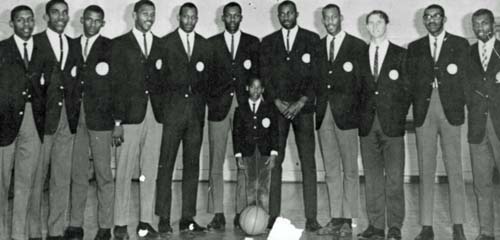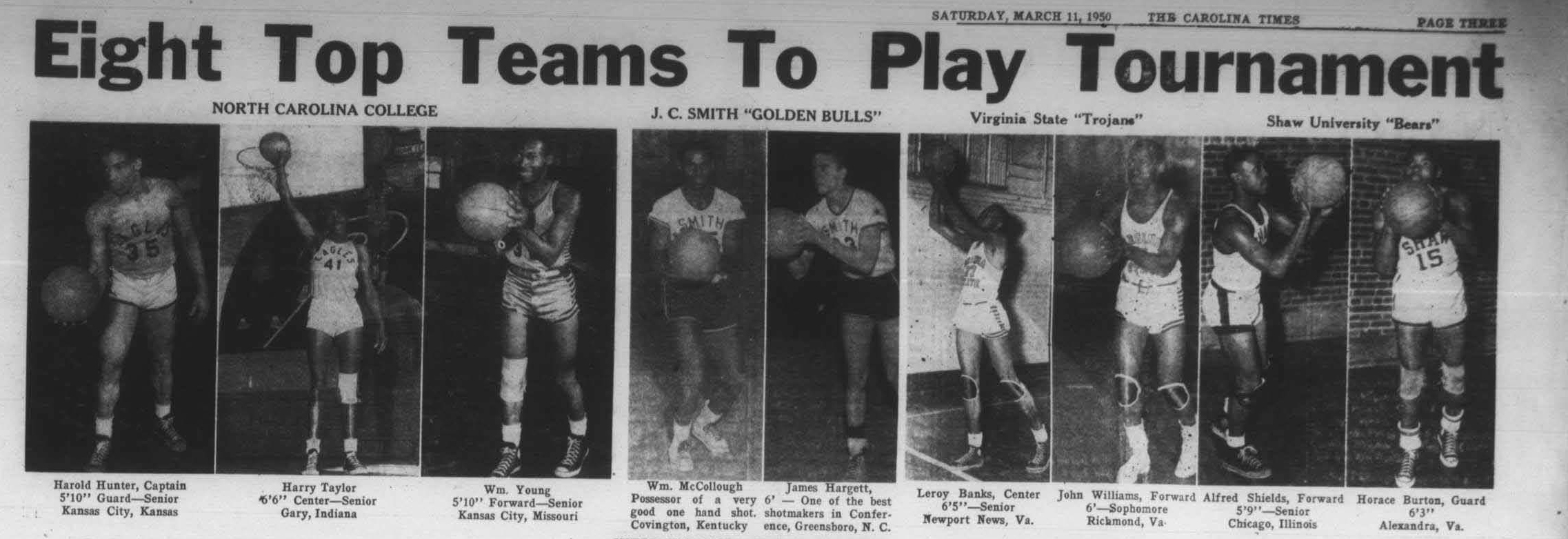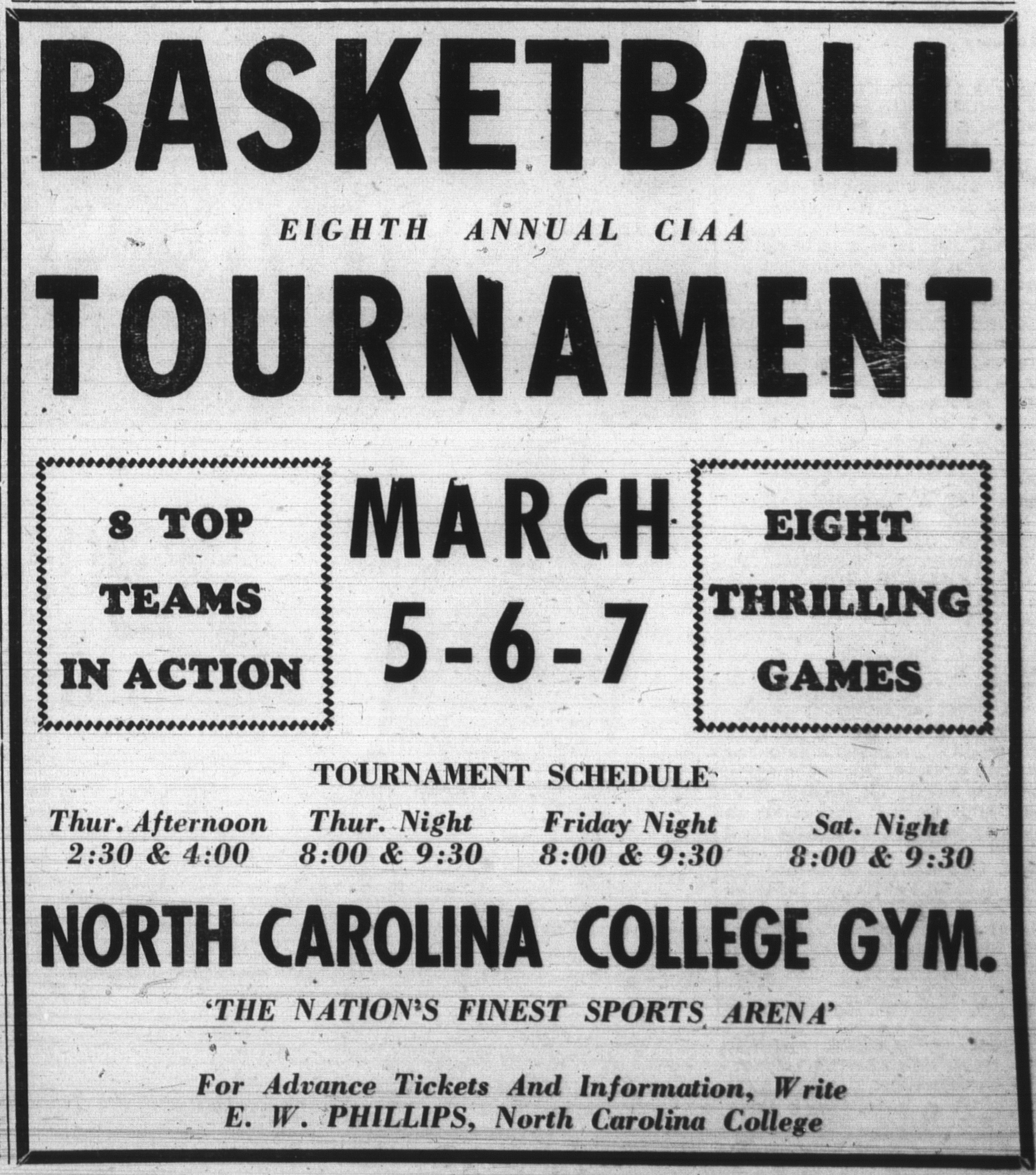Viewing search results for "Johnson C. Smith University"
View All Posts
About six months ago we asked our partners to help us increase the diversity of voices shared on DigitalNC. We had an outpouring of interest, and partners have shared a number of rich collections from the African American and LGBTQ communities. Here’s an update of what has been added to DigitalNC as a result of this call.
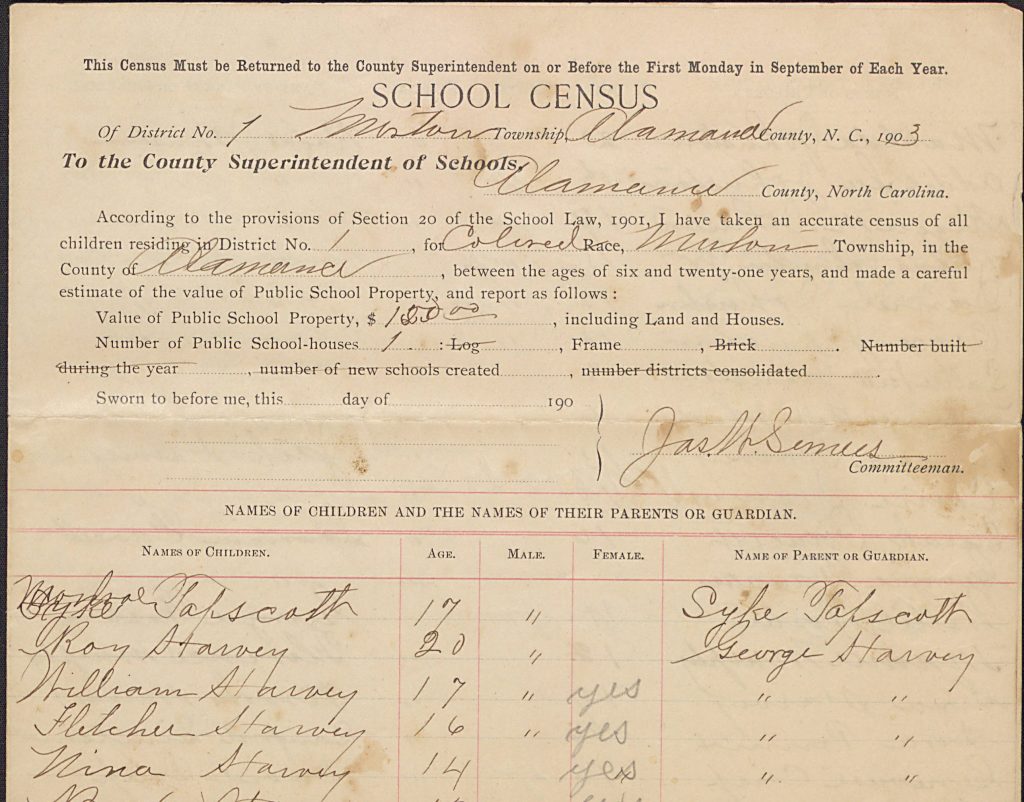
This 1903 Census Report for Morton Township, Alamance County, lists names, ages, and the names of parents of African American students.
Alamance County Public Libraries shared a wide variety of materials documenting African American communities in that county. Two groups of photographs, the Heritage of Black Highlanders and Asheville YWCA Photograph Collection, are parts of larger collections held by University of North Carolina at Asheville.
Several partners added African-American newspapers to those already shared online at DigitalNC.
We’ve also been working with University of North Carolina at Charlotte to share issues of Q-Notes, which covers updates, events, and issues of the LGBTQ community.
Diversifying DigitalNC isn’t a one-time event – it’s ongoing every day. If your institution has or will be targeting collections that document racial, ethnic, or geographic communities who are underrepresented on DigitalNC, and you’re interested in sharing these materials online, get in touch.
Mascots are a complicated phenomenon. They inspire a spectrum of reactions: ridicule, ambivalence, or fierce loyalty. With thousands of yearbooks online, all of us here at the Digital Heritage Center have probably spent more time looking at yearbooks than anyone else you’re likely to meet. Mascots are a common theme.
I’ve been working on today’s post for quite some time; unable to find a history or comprehensive list of mascots in North Carolina I decided to compile one myself. So here’s a stab at a college mascot overview, drawn from yearbooks and other campus publications. Let me know what I’ve missed or gotten wrong!
Children
In the early 20th century, schools frequently chose children as mascots or sponsors, whether for a sports team or for a particular class. The earliest example we’ve found on DigitalNC is from a 1910 publication by Atlantic Christian College (now Barton College) in Wilson, which shows Elizabeth Settle Caldwell as the Senior Class sponsor.
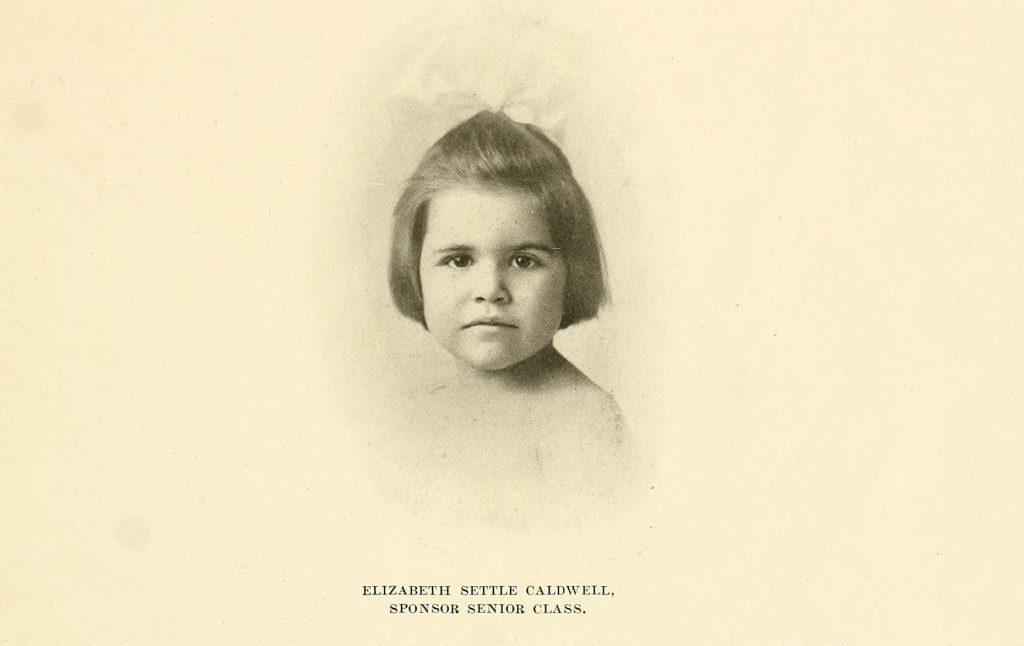
Elizabeth Settle Caldwell, First North Carolina Mascot? From the 1910 Pine Knot yearbook, Atlantic Christian College.
Ms. Caldwell was the daughter of Jesse Cobb Caldwell, the college president. From what we’ve been able to tell, children mascots were frequently younger siblings of students, teachers, or others associated with the school. Students mention that Ms. Caldwell brought “solace to many a lonely, homesick heart” and this may be why children were chosen – to foster a feeling of family and comfort among students. We’ve seen several references to mascots being elected or being chosen through competition, although what this might be we haven’t been able to discover. The trend of choosing children as mascots seems to continue through the 1960s. The latest one we found is Dawn, the Senior Class mascot at Peace College (now William Peace University) in 1966.
Animals
Animal mascots span schools across the state, whether it’s Rameses at UNC-Chapel Hill or WCU’s Catamount. The bulldog and different types of cats win out as most frequently adopted. Pictures of live animal mascots start to appear in yearbooks in the early 1900s, and continue today although much less frequently. For a variety of reasons, including concerns expressed by animal rights activists, schools have shifted away from actual animals to students dressing up like animals, as you’ll see later on in this post.
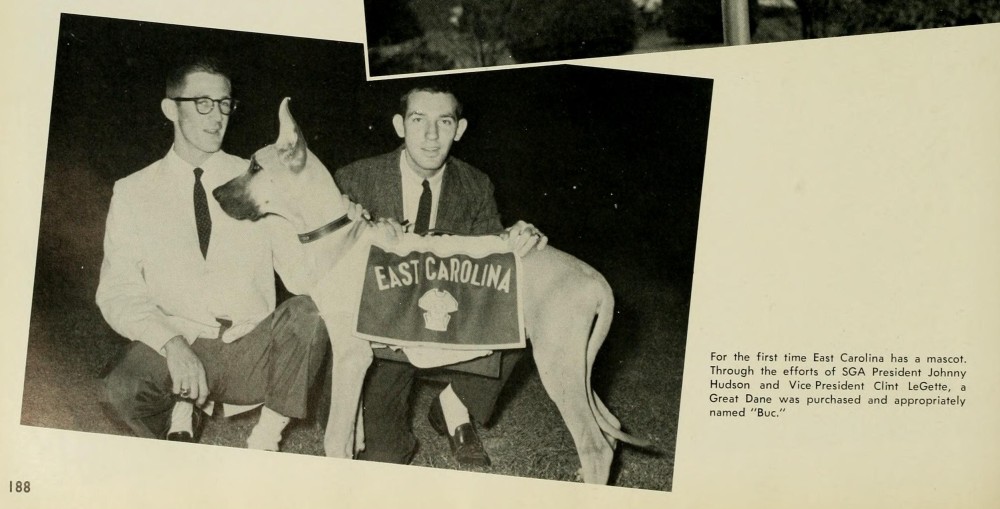
“Buc” is described here as East Carolina University’s first mascot. From the 1959 Buccaneer yearbook.
Characters
While about half of the four-year college mascots in North Carolina are animals, most of the others are characters that are historic, mythical, or extraordinary in nature. From what I’ve seen in NC yearbooks, humans dressing up as the school mascot really got traction in the 1960s. Initially, these costumes weren’t the fuzzy creations we think of today, but rather less complicated ensembles where the mascot’s identity (his or her face and body) was often apparent. Yosef the Mountaineer, beloved icon of Appalachian State University, was created sometime around 1942 and looked like this in the 1960s:
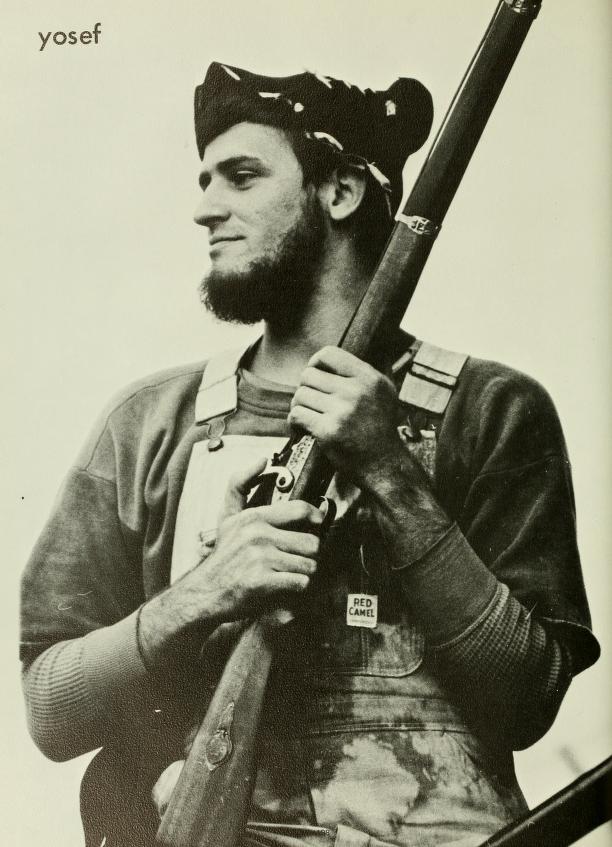
Yosef the Mountaineer, aka James Randle Tedder (we think). From the 1969 Rhododendron yearbook, Appalachian State University.
One of my favorites has to be this picture of Duke Blue Devil, from 1950:
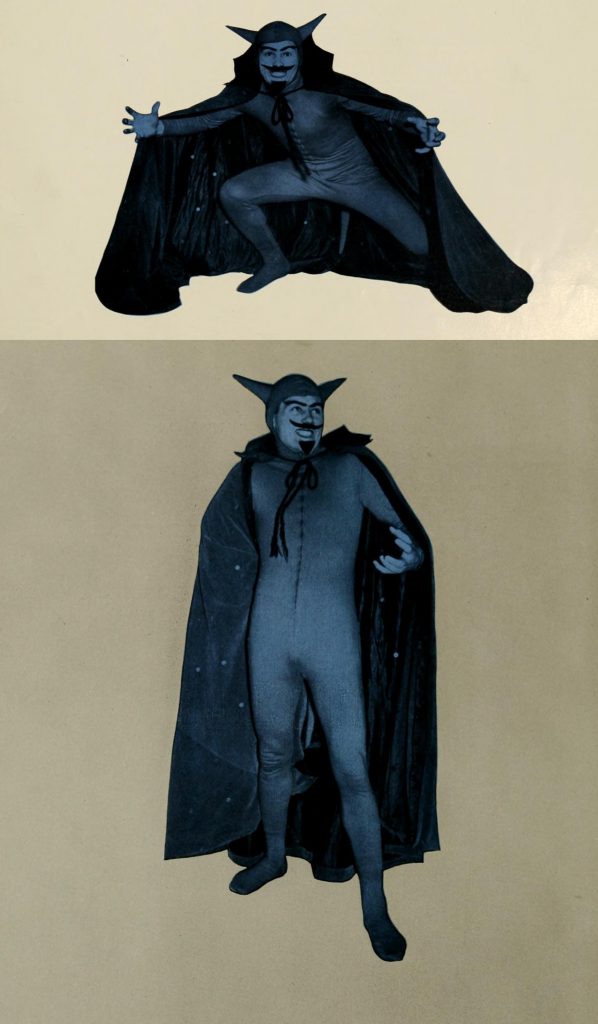
The Blue Devil. From the 1950 Chanticleer yearbook, Duke University.
Perhaps it was too hard to maintain a degree of consistency as students graduated over the years, and mascot anonymity seemed like a better idea. Whatever the reason, you start to see fuzzy, oversized costumes with gigantic headpieces in the late 1970s.
The Big Costumes
Whether animal or character, plush mascots that include a single piece body suit with a large plastic or cloth-covered head is something most Americans can identify with, thanks to professional sports. Colleges in North Carolina really embraced these costumes through the 1980s. Here’s what the UNC-Wilmington Seahawk looked like in 1987:

The Seahawk. From the 1987 Fledgling yearbook, UNC-Wilmington.
Some schools have developed multiple mascots dedicated to different audiences. It seems like the difficulty with these types of costumes is how to pull off a fierce facial expression that doesn’t come off as goofy or too scary for children. I think this picture from Davidson College sums it all up:
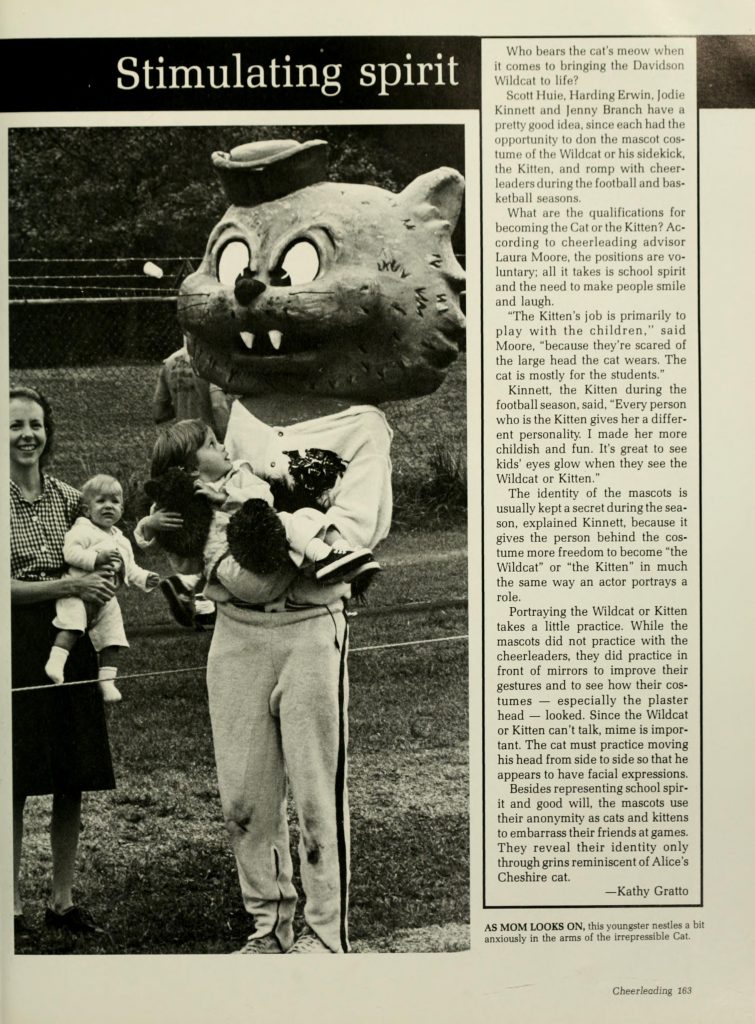
The Davidson Wildcat and … friends. From the 1983 Quips and Cranks yearbook.
I will also take this opportunity to mention a mascot that routinely makes the “wait … what?” list – the Campbell University Fighting Camels:
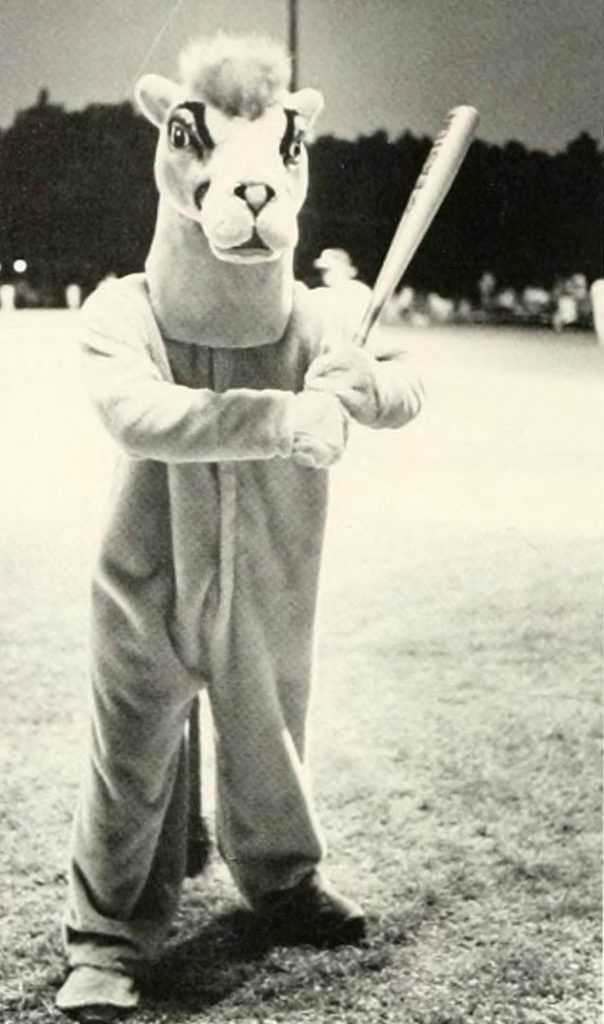
The Campbell Camel. From the 1983 Pine Burr yearbook.
Even the humans and human-like creatures are clothed in oversized costumes these days. Wake Forest University’s Deacon is a dapper chap:
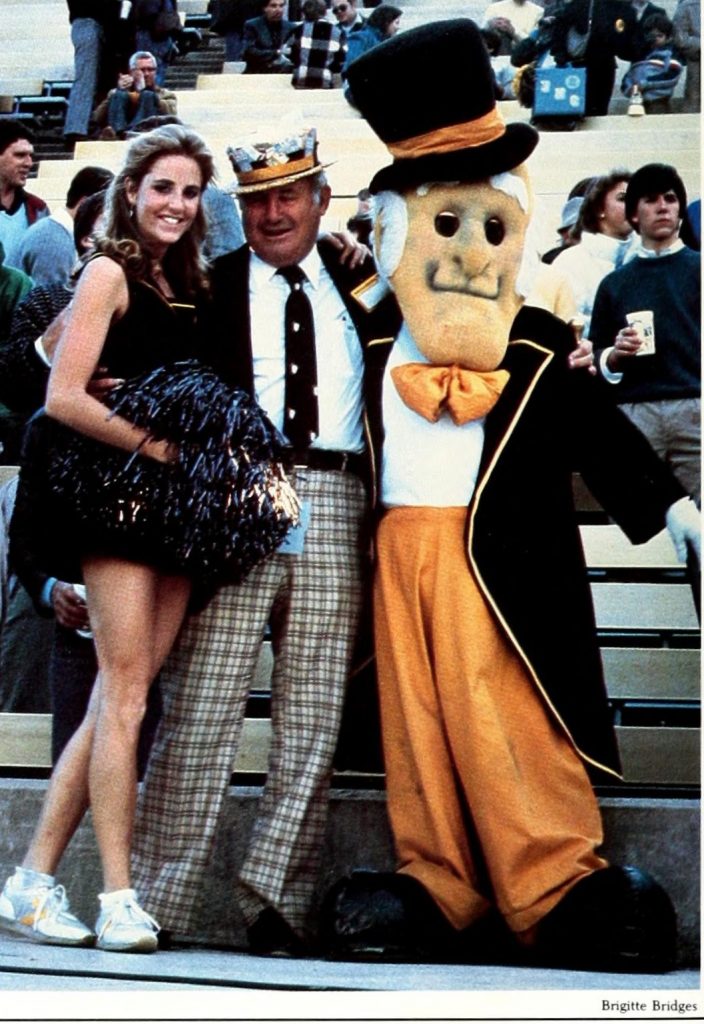
Wake Forest’s Deacon poses with fans. From the 1985 Howler yearbook.
In addition to the Demon Deacons and the Blue Devils, North Carolina boasts a number of other spiritual mascots: North Carolina Wesleyan’s Battling Bishops, Belmont Abbey’s Crusaders, and Guilford College’s Quakers. Meredith College’s teams are known as the Avenging Angels (formerly just the Angels). While Elon University’s mascot is now the Phoenix, before 2000 they were the Fighting Christians:
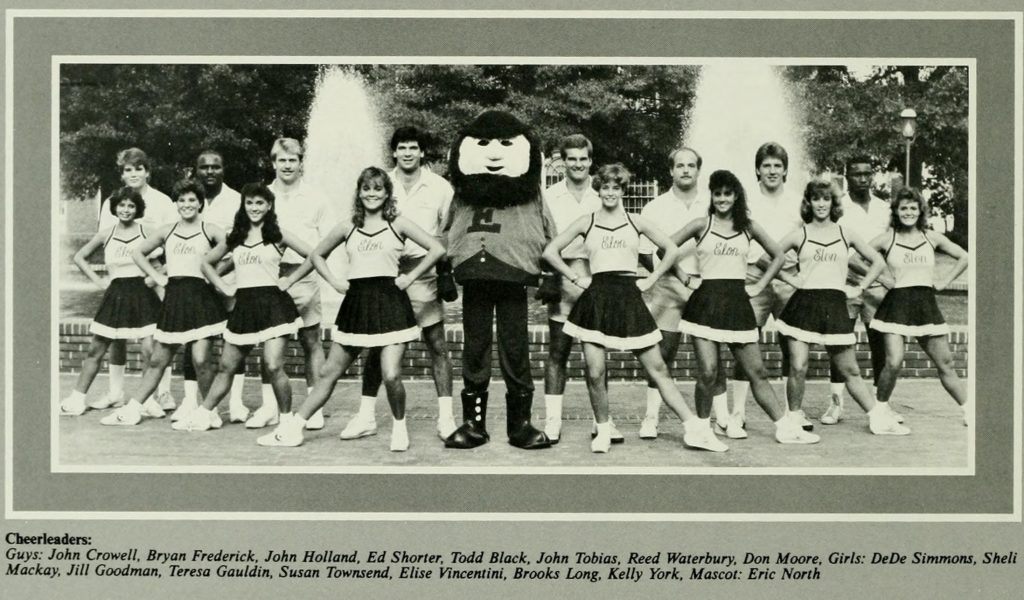
The Elon Fighting Christian mascot with cheerleaders. From the 1986 Phi Psi Cli yearbook.
Two schools break with the animal/human tradition in North Carolina. The Brevard College Tornadoes and the Louisburg College Hurricanes. Weather phenomena mascots are always difficult to pull off. I couldn’t find one for Brevard, but Louisburg, which currently has a bird mascot, had “Louie” up until 2006:
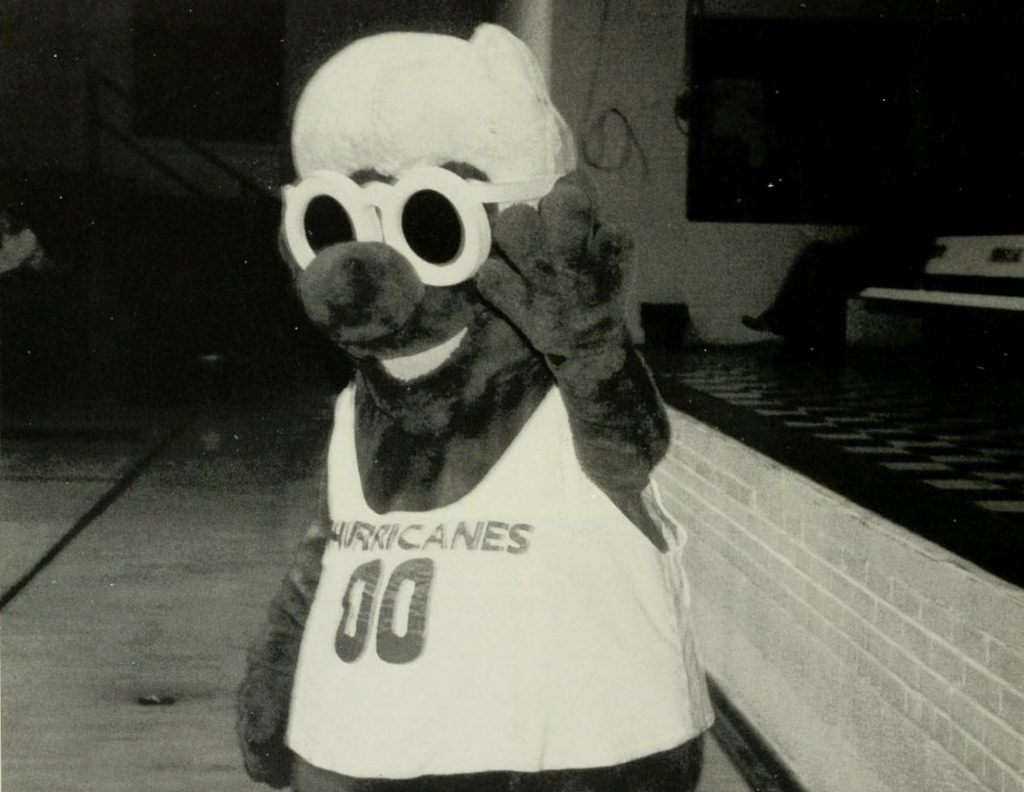
Louie, the former Louisburg College Hurricanes mascot. From the 1996 The Oak yearbook.
Who knows when the next mascot sea change will happen. Below is a list of mascots in North Carolina; let us know if we got anything wrong. Which one is your favorite?
| School |
Mascot |
Notes |
| Appalachian State University |
Yosef the Mountaineer |
First appeared in the yearbook in 1942 |
| Barton College |
Bulldog |
|
| Belmont Abbey College |
Crusader |
|
| Bennett College |
|
Known as the Bennett Belles |
| Brevard College |
Tornado |
|
| Campbell University |
Fighting Camels |
The Hornets in the 1920s-1930s |
| Catawba College |
Catawba Indian |
|
| Chowan University |
Hawks |
The Braves until 2006 |
| Davidson College |
Wildcats |
Also a bulldog (1929) and a bobcat (1939) |
| Duke University |
Blue Devil |
|
| East Carolina University |
Pirates |
Formerly Pee Dee the Pirate |
| Elizabeth City State University |
Vikings |
|
| Elon University |
Phoenix |
The Fightin’ Christians until 2000 |
| Fayetteville State University |
Broncos |
|
| Gardner-Webb University |
Runnin’ Bulldogs |
|
| Greensboro College |
The Pride |
Formerly the Hornets |
| Guilford College |
Quakers |
|
| High Point University |
Panthers |
|
| Johnson C. Smith University |
Golden Bulls |
|
| Lees-McRae College |
Wily the Bobcat |
|
| Lenoir-Rhyne University |
Joe and Josie Bear |
|
| Louisburg College |
Hurricanes |
|
| Mars Hill College |
Mountain Lion |
|
| Meredith College |
Avenging Angels |
Formerly the Angels |
| Methodist University |
Eagles |
|
| Montreat College |
Cavaliers |
|
| Mount Olive College |
Trojans |
|
| North Carolina A&T |
Aggie Dog (Bulldog) |
|
| North Carolina Central University |
Eagles |
|
| North Carolina State University |
Wolfpack |
|
| North Carolina Wesleyan College |
Battling Bishops |
Formerly the Circuit Riders |
| Peace College |
Pacer |
|
| Pfeiffer University |
Falcons |
|
| Queens University of Charlotte |
Rex the Royal |
|
| Saint Augustine’s University |
Mighty Falcons |
|
| Salem College |
Spirits |
|
| Shaw University |
Bears |
|
| St. Andrews University |
Knights |
|
| UNC Asheville |
Bulldog |
|
| UNC Chapel Hill |
Rameses the Ram |
Also known as the Tar Heels |
| UNC Charlotte |
Norm the Niner |
|
| UNC Greensboro |
Spartans |
|
| UNC Pembroke |
Braves |
|
| UNC Wilmington |
Seahawk |
|
| UNC School of the Arts |
Fighting Pickle |
|
| UNC School of Science and Math |
Unicorn |
|
| Wake Forest University |
Demon Deacons |
|
| Warren Wilson College |
Owls |
|
| Western Carolina University |
Catamount |
“Paws” |
| Wingate University |
Bulldog |
|
| Winston-Salem State University |
Ram |
|
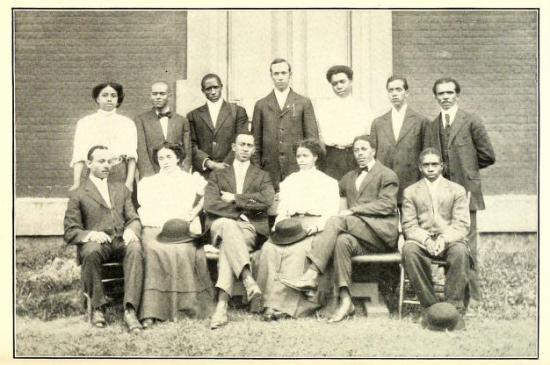
Students at Shaw University, 1911.
With the recent addition of student yearbooks from Livingstone College, DigitalNC now hosts historic materials from ten different Historically Black Colleges and Universities in North Carolina. These materials document more than a century of African American higher education in North Carolina. From our earliest projects in 2010 to the present, the North Carolina Digital Heritage Center has worked closely with libraries and archives at historically Black colleges around the state, and we continue to add materials from these collections on a regular basis. Follow the links below to browse yearbooks, newspapers, photos, scrapbooks, and more materials by school.
Bennett College (Greensboro)
Elizabeth City State University
Fayetteville State University
Johnson C. Smith University (Charlotte)
Livingstone College (Salisbury)
North Carolina A&T (Greensboro)
North Carolina Central University (Durham)
Saint Augustine’s University (Raleigh)
Shaw University (Raleigh)
Winston-Salem State University
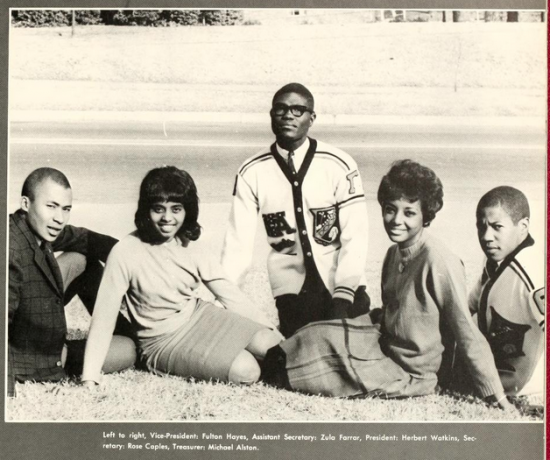
Sophomore class officers at North Carolina Central University, 1963.
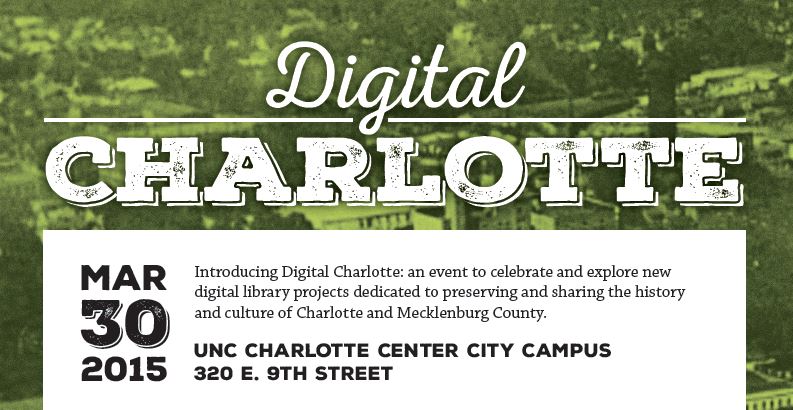
If you’re in the Charlotte area and interested in local history and digital libraries, please mark March 30 on your calendars: we will be holding an event to celebrate and explore digital library efforts in Charlotte and Mecklenburg County. Here are the details:
Event: Digital Charlotte: Celebrating and Exploring Local Digital Library Projects
Date: March 30, 2015
Time: Talk at 6:30, followed by a reception
Location: UNC Charlotte Center City Campus, 320 E. 9th St.
Parking information: http://www.charlottecentercity.org/transportation/parking/
Admission: Free and Open to the Public
Questions?: Write digitalnc@unc.edu or call 919-962-4836
“Digital Charlotte” will feature a talk by Julie Davis, Project Director, Digital Loray, and Public Historian in Residence at the Loray Mill, who will speak about the role of public history in the redevelopment of the Loray Mill in Gastonia. The talk will be followed by a reception during which guests can see demonstrations of digital projects from local libraries including UNC-Charlotte, the Charlotte Mecklenburg Library, Johnson C. Smith University, and Davidson College. This will be a terrific opportunity for local genealogists and history buffs to learn more about the rapidly-growing number of online resources devoted to local history. We are also encouraging Charlotte-area librarians, archivists, and students to attend and participate.
This event is being held as part of our work on a recent grant from the Digital Public Library of America. The grant funding has enabled us to expand our services for libraries, archives, and museums around the state. The DPLA is the primary sponsor of the Digital Charlotte event. Additional support is being provided by the Olde Mecklenburg Brewery.
Please contact us if you have any questions. We hope to see many of you in Charlotte!
We wrote about May Queens a couple of years ago, but can’t help showcasing them again. This time, we’re bringing you a gown per decade from North Carolina’s High Schools, Colleges, and Universities. (We picked 2 from the 1990s because we just couldn’t decide.)
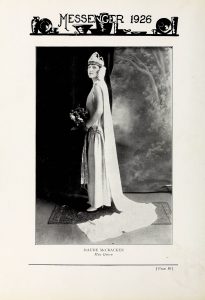
Maude McCracken, May Queen in 1926
The Messenger Yearbook, 1926 (courtesy Durham Public Library)
The Lotus Yearbook, 1938 (courtesy William Peace University)
The Anchor Yearbook, 1948 (courtesy Gardner-Webb University)
B-Somebody Yearbook, 1958 (courtesy Edgecombe County Memorial Library)
The Zenith Yearbook, 1964 (courtesy High Point University)
The Golden Bull Yearbook, 1972 (courtesy Johnson C. Smith University)
The Circle Yearbook, 1986 (courtesy Mitchell Community College)
Arete Yearbook, 1990 (courtesy Queens University of Charlotte)
The Gate Yearbook, 1991 (courtesy Wingate University)
The Central Intercollegiate Athletic Association (CIAA), founded in 1912, is celebrating its centennial as basketball teams from twelve member institutions and fans gather today in Charlotte to kick off the annual tournament.
This article from today’s News & Observer tells the story of the CIAA basketball conference.
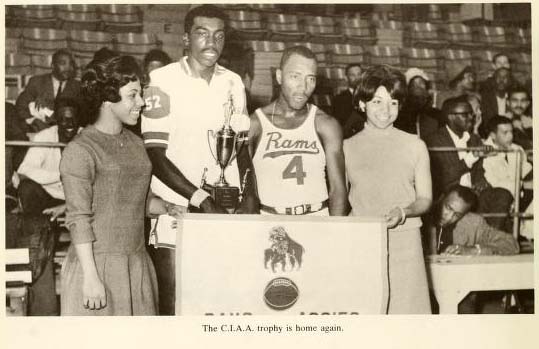
Earl “The Pearl” Monroe and others. The Winston-Salem State College Rams brought home the CIAA trophy in 1967. Image from the 1967 volume of “Red and White,” the Winston-Salem State University student yearbook.
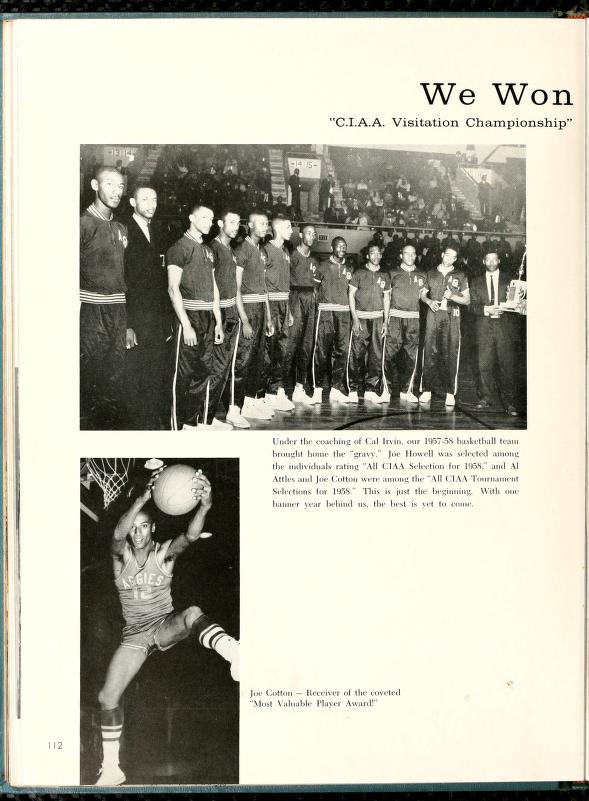
Page from the 1958 edition of “The Ayantee,” North Carolina Agricultural and Technical University’s student yearbook, depicting that year’s CIAA championship team.
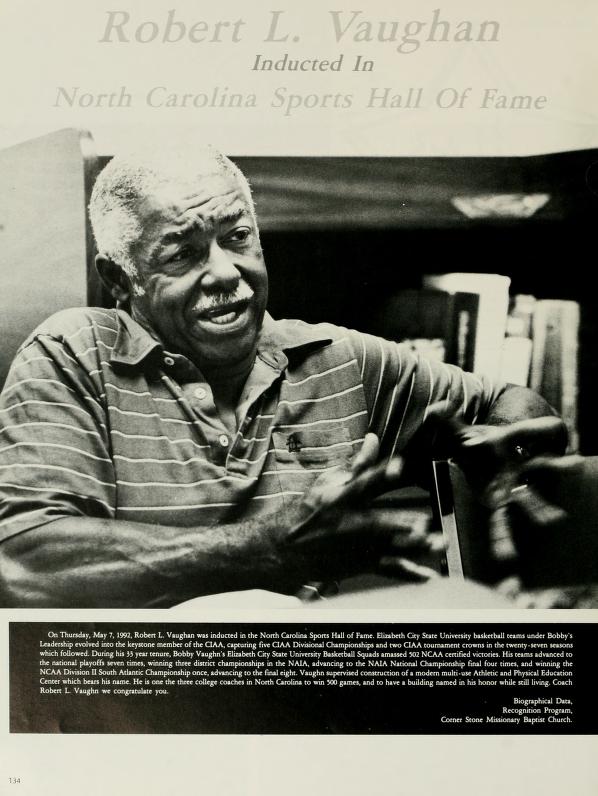
In 1992, Elizabeth City State University basketball coach Bobby Vaughan was inducted into the North Carolina Sports Hall of Fame. Under Vaughan’s leadership, the basketball team won five CIAA Divisional Championships and two CIAA tournaments. Image from the 1992 volume of “The Viking,” the Elizabeth City State University student yearbook.
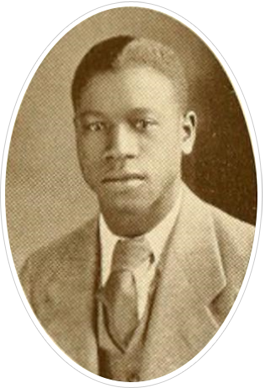
Early issues of The Golden Bull, the student yearbook from Johnson C. Smith University, are now available on DigitalNC. One of North Carolina’s early jazz bandleaders is pictured in the 1930 volume. Campbell Aurelius Tolbert, known professionally as “Skeets” Tolbert, grew up in Lincolntown, N.C. Tolbert’s professional career spanned the 1930s and 1940s, first as a backup musician and then as the leader of a group called The Gentlemen of Swing. The Gentlemen of Swing toured the east coast, and had a few of their songs captured on film, one of which, “No No Baby,” is available on YouTube.
Tolbert lived in Charlotte again in the late 1940s when he taught high school music before moving to Texas, where he lived for the remainder of his life.
About two years ago, we had the honor of hosting a group of students from Wilmington who were studying one of the most politically and socially devastating moments in the state’s history–the Wilmington Coup and Race Riots of 1898. Their efforts centered around locating and studying the remaining issues of the newspaper at the center of that event, the Wilmington Daily Record. Owned and operated by African Americans, this successful paper incited racists who were already upset with the political power held by African Americans and supporters of equality. During the Coup, the Record’s offices were burned and many were killed. Thanks to these students, their mentors, and cultural heritage institutions, you can now see the seven known remaining issues of the Daily Record on DigitalNC.
Our main contact on this project has been John Jeremiah Sullivan, a well known North Carolina author and editor. He originally approached us back in 2017 to enlist our help and, since then, has been working with a cohort of supporters, volunteers, and students to dig deeper into the Daily Record and to raise further awareness of its history. Today we’re excited to share the Project’s latest efforts in Sullivan’s own words below.
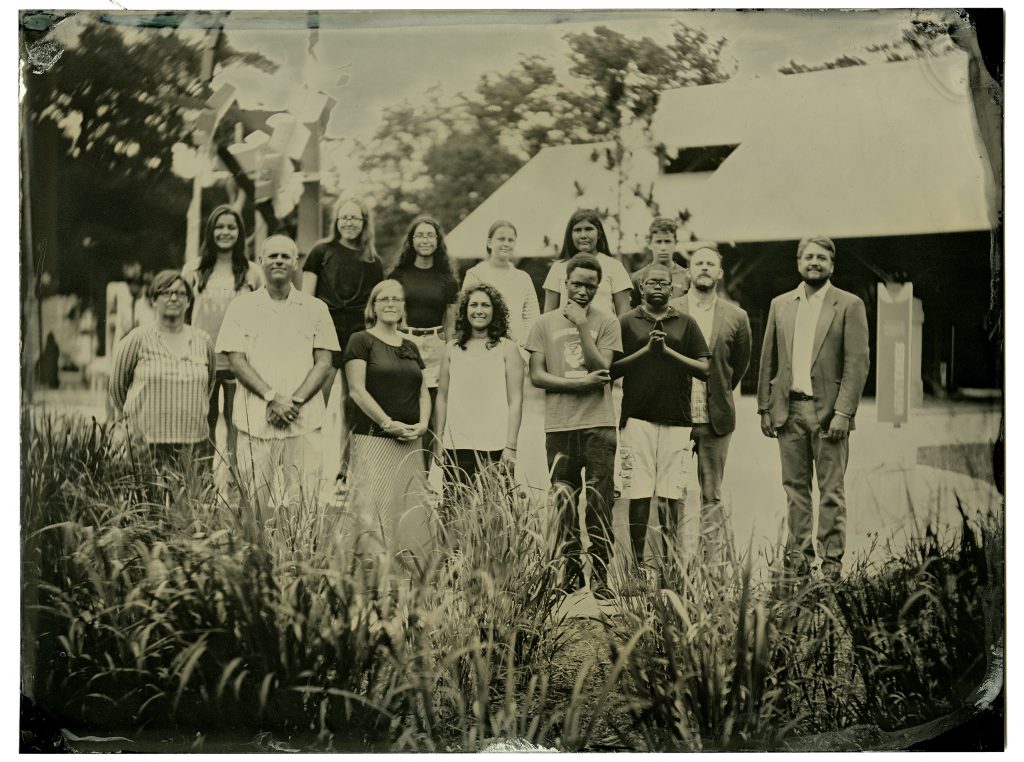
Daily Record Project Historians, taken by Harry Taylor in May 2017 at the Cape Fear Museum
Highlights
- Over the past few years, Wilmington middle school students have been combing through newspapers, periodicals, manuscripts, and other publications contemporaneous with The Daily Record searching for content from the Record that is quoted in those sources.
- Their efforts yielded numerous quotes, which have been assembled into what they’re calling a “Remnants” issue of the Record.
- Literary content, biographical information about the Record’s editors, Wilmington political news and more can be found in this issue.
- For the first time in one place you can read content that was published in issues of the Record that may no longer exist.
The Daily Record Project
by John Jeremiah Sullivan
“For the past four years, Joel Finsel and I, in conjunction with the Third Person Project, have been meeting weekly with groups of Wilmington 8th-graders to learn as much as we can about the Wilmington Daily Record, the African American newspaper destroyed at the start of the race massacre and coup d’état that turned Wilmington upside down in November of 1898. At the heart of the original Daily Record Project was an attempt to locate any surviving copies of the paper. Books and essays about the massacre always include a sentence along the lines of, ‘Sadly no copies remain,’ but it seemed impossible that they could all have disappeared. After three years’ hunting, we were able to identify seven copies–three in Wilmington, at the Cape Fear Museum (the staff historian there reached out to make us aware of their existence), three at the Schomburg Center for Research in Black Culture in New York City, and one at the State Archives of North Carolina in Raleigh. (The latter is a mostly illegible copy of the issue containing Alex Manly’s editorial of August 18, 1898, the article seized on by white supremacists as a pretext for stirring up race-hatred in the months before the massacre.) These seven copies, thanks to the North Carolina Digital Heritage Center, can now be examined online by anyone with an Internet connection. For the first time in more than a hundred years, it is possible to read one of the most famous and important African American newspapers of the late-nineteenth century.
“When those seven copies had been thoroughly read through and annotated, and it did not seem that any more were going to surface (at least not in the near future), we found ourselves faced with the question of “What next?” Should we discontinue the project? We had no desire to do that—it had been too much fun and we were learning too much. We had developed rewarding relationships with the three middle schools that sent their students to study with us: Williston School, D.C. Virgo Preparatory Academy, and the Friends School of Wilmington. The Daily Record Project had become a kind of field laboratory for excavating more information about the events of 1898 and Wilmington history more largely. The last thing we wanted was to shut that down.
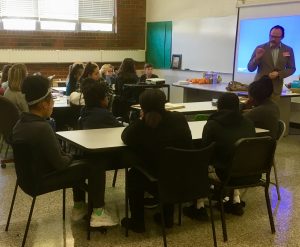
John Jeremiah Sullivan addressing the Daily Record Project class at DC Virgo Preparatory Academy, 2019
“We had noticed, in the course of studying the seven copies, that there did exist, in various sources from that period, isolated fragments of text from various issues of the Record that may no longer exist. We were finding these fragments in other newspapers. Just as publications do today, papers were reprinting one another’s material. Sometimes it was in the form of a quotation—several paragraphs, or even just a sentence. Sometimes whole articles were being re-published. In a couple of cases, the text survived by way of advertisement: a traveling circus, for instance, had liked what the Record said about it when it passed through Wilmington, and used that paragraph in announcing future appearances. We started wondering how many of these “ghost” stories might exist. The more we looked, the more we found. We enlisted the 8th graders to help us search. They turned up even more stuff. The range of sources we were using expanded. From old newspapers we moved on to magazines and books and pamphlets and letters. Often the writers or editors doing the quoting were critical of, or even hostile to, the Record and its politics. In attacking pieces from the Record that had offended them, they were unwittingly preserving more of that newspaper’s copy for future generations.
“By the time it was over, we had a folder containing scores of these “remnants,” as we were calling them, enough to create an entire new issue–a “ghost issue”–of the Daily Record, and that is what we have done.
“To create the actual issue, we worked with a brilliant graphic designer in New York named Stacey Clarkson James, who for many years had been the Art Director at Harper’s Magazine. I had worked with Stacey at Harper’s many years ago and have collaborated with her many times since. She exceeded even our high expectations by designing a newspaper issue that is not so much an imitation of the original Daily Record as a resurrection. She went in and crafted, by hand, a typeface that matches the now-extinct one used by Alexander Manly and the original editors. Then she laid out the pages according to the old 1890s press-style, even dropping in advertisements that we knew to have appeared in the Record. At the top it says REMNANTS. We gasped when we saw it.
“On the second page, above the masthead, can be seen a list of sources we used. There are a lot of them. The very size and range of the list shows the scope of the Record’s notoriety in its day. It was being read in many parts of the country.
“Maybe the most interesting thing about this issue is that, because it consists only of material that other publications found interesting enough to re-print, it winds up forming a kind of Greatest Hits compilation (though all of these “hits” have been buried in other papers until now). It’s a fascinating issue to read. There are articles on politics, culture, and social life, as well as strange unplaceable pieces, like the one about a man in Arkansas who caught fire in his orchard and just kept burning. No one could put him out. We still aren’t sure what that one means.
“Two of many things worth highlighting within the “Remnants” issue:
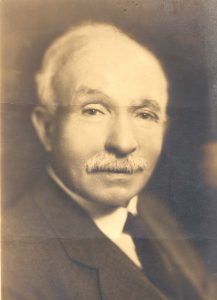
Charles W. Chesnutt, Charles Chesnutt Collection, Fayetteville State University Library.
“First–at the center of the issue is Charles Chesnutt’s short story, “The Wife of His Youth.” Chesnutt was, of course, one of the first great African-American fiction writers, and the novel that many consider to be his greatest work, The Marrow of Tradition, is a re-telling of the events of 1898, set in a fictionalized Wilmington that he calls Wellington. Chesnutt had many and deep ties to this city, more than most scholars are aware. (His cousin, Tommy Chesnutt, was the “printer’s devil” or apprentice at the Daily Record–you can find his name on the masthead on page 2.) “The Wife of His Youth” is probably Chesnutt’s best-known story. What’s curious is how we learned that it ran in the Daily Record. In Chesnutt’s published correspondence, there is a letter to Walter Hines Page, his editor at the Atlantic Monthly. It’s basically a letter of complaint: Chesnutt is telling Page that Alex Manly had reprinted the story (serially) in the Record, without having asked permission. At the time of that writing the Record had already been burnt and Manly had fled Wilmington, so Chesnutt essentially says, I guess we can give him a pass… But the complaint contained valuable information, because it tells us that the Record had an ongoing literary dimension. Manly was likely running stories and poems quite frequently—one of the seven surviving copies also contains a short story, “The Gray Steer” by one Frank Oakling. It’s on page 3 of the August 30th, 1898 issue.
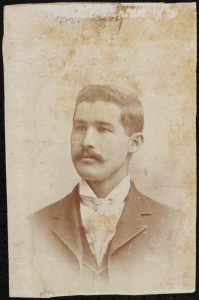
Alexander Manly, in the John Henry William Bonitz Papers #3865, Southern Historical Collection, The Wilson Library, University of North Carolina at Chapel Hill.
“Second–readers will notice that at the end of the “Remnants” issue, in the last couple of columns on the last page, there is a series of articles from not the Wilmington Daily Record but the *Washington* Daily Record. These represent probably the most exciting discovery we made during this most recent session of the Daily Record Project. The way the story of 1898 traditionally gets told, the massacre and coup d’état marked the end of the Manly brothers’ journalistic careers: they left the city, their ambition blighted, and sank into relative obscurity. The reality could not have been more different. It turns out that the Manlys went almost immediately to Washington, D.C., and re-established the Daily Record there. Before a year was out, they had the press up and running. They operated the Daily Record for four more years in the capital, then handed it off to another editor, who ran it for another six or seven. One of their articles included here is a stirring anti-imperialist denunciation of American military intervention in the Philippines. Another describes the renaissance in African-American literary activity that was felt to be happening around the turn of the century. As far as we can determine, these few pieces represent the only extant copy from the *Washington* Daily Record, for its entire decade-long run.
“There is much more worth unpacking, but we want to allow visitors to the NC Digital Heritage Center’s website to have the fun of doing that themselves.
“Long live the Daily Record. Thank you for reading.
“There are a lot of people to thank. First, the incredible 8th-grade students participated in the “Remnants” session of the Daily Record Project. It was a privilege to work with them and be around their energy:
- Ridley Edgerton
- Bella Erichsen
- Dymir Everett
- Love Fowler
- Malakhi Gordon
- Heaven Loftin
- Katy McCullough
- Juan Mckoy
- Shalee Newell
- Isis Peoples
- Nakitah Roberts
- Gabe Smith
- Maria Sullivan
- Latara Walker
- Ramya Warren
“Second, the adults (teachers, administrators, chaperones, donors, friends, and Third Person Project members) who contributed every week to making this year’s work possible:
- Rhonda Bellamy
- Dan Brawley
- Laura Butler
- Stacey Clarkson James
- Michelle Dykes
- Clyde Edgerton
- Brenda Esch
- Joe Finley
- Cameron Francisco
- Sabrina Hill-Black
- Mariana Johnson
- Trey Morehouse
- Tana Oliver
- Donyell Roseboro
- Elliot Smith
- Beverley Tetterton
- Larry Reni Thomas
- Candace Thompson
- Leyna Varnum
- Tony Ventimiglia
- Florence Weller
- The Cape Fear Museum
- NC State Archives
- The Schomburg Center
“And finally, a shout-out to the Digital Heritage Center. Thanks to you, more than 120 years after white supremacists tried to erase the Daily Record, people are reading it again.”
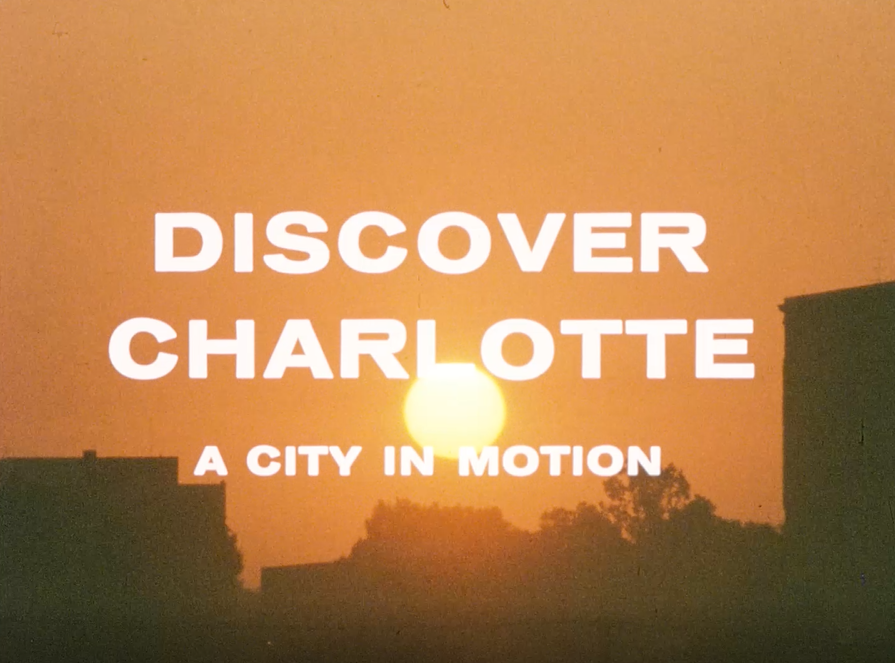
In partnership with the Charlotte Mecklenburg Library we’re pleased to share this 1968 film entitled Discover Charlotte – A City in Motion. Created by the Charlotte Chamber of Commerce and narrated by famous journalist and North Carolinian Charles Kurault, this promotional film boasts about Charlotte’s industrial and economic growth.
 In color with an upbeat soundtrack, Discover Charlotte lauds the motion of Charlotteans, beginning with a look at the city’s role in trucking, rail, and air transport. Turning to the banking industry, the film shows people processing large amounts of checks and cash and using adding machines at lightning speed. Shots of the Charlotte Record newspaper offices include coverage of Record employees learning via Teletype that Gene Payne, the Record’s cartoonist, had won a Pulitzer. You’ll see pilots and passengers at the Charlotte Douglas airport, Arthur “Guitar Boogie” and the Crackerjacks playing at the WBT station, computers whirring in a new data processing center, workers constructing a Duke power complex, and researchers examining newly woven textiles.
In color with an upbeat soundtrack, Discover Charlotte lauds the motion of Charlotteans, beginning with a look at the city’s role in trucking, rail, and air transport. Turning to the banking industry, the film shows people processing large amounts of checks and cash and using adding machines at lightning speed. Shots of the Charlotte Record newspaper offices include coverage of Record employees learning via Teletype that Gene Payne, the Record’s cartoonist, had won a Pulitzer. You’ll see pilots and passengers at the Charlotte Douglas airport, Arthur “Guitar Boogie” and the Crackerjacks playing at the WBT station, computers whirring in a new data processing center, workers constructing a Duke power complex, and researchers examining newly woven textiles.
Most of the film features scenes of middle and upper class white Charlotteans in work, social, or religious settings. In Charlotte, there is “a church for every man” and there are brief views of a number of religious institutions including Covenant Presbyterian Church, Dilworth Methodist Church, Holy Trinity Greek Orthodox Cathedral. Other events and activities shown in the film include
- Festival in the Park at Freedom Park,
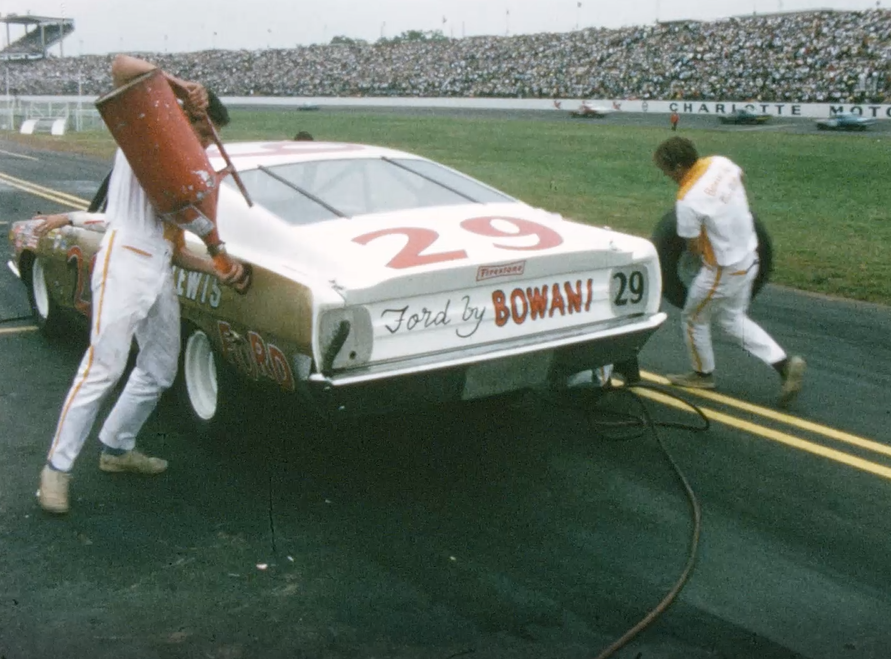
- the Mint Museum Drama Guild rehearsing a play,
- a wedding reception for an unnamed white couple,
- a Carolina v. NC State basketball game,
- a Charlotte Checkers hockey game, and
- a NASCAR stock car race.
There are also views of two university campuses, Johnson C. Smith and the relatively new UNC-Charlotte.
Filmed during the Civil Rights movement, there are only brief allusions to racial tensions. There is a snippet of white police officers talking about “riding with Negro officers,” which cuts to a group of black men and officers talking about a local march. The end of the film describes Charlotte’s participation in the Model Cities initiative and its “total attack on poverty,” efforts that were meant to eradicate urban blight that, as in many cities in America, ended up displacing and/or destroying minority-owned homes and businesses. The film ends with drawings of a planned expressway, widened streets, parks, new hotels and high rises.
This is one of a number of items Charlotte Mecklenburg Library has shared on DigitalNC. You can see more on their contributor page or learn more about their North Carolina collections on their website.















